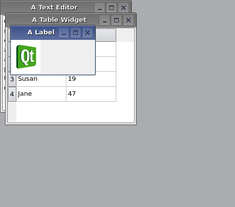QWorkspace Class Reference |
 |  |
If you want your users to be able to work with child windows larger than the visible workspace area, set the scrollBarsEnabled property to true.
See also QDockWidget and MDI Example.
Member Type Documentation
enum QWorkspace::WindowOrder
Specifies the order in which child windows are returned from windowList().
| Constant | Value | Description |
|---|---|---|
| QWorkspace::CreationOrder | 0 | The windows are returned in the order of their creation |
| QWorkspace::StackingOrder | 1 | The windows are returned in the order of their stacking |
Property Documentation
background : QBrush
This property holds the workspace's background.
Access functions:
- QBrush background () const
- void setBackground ( const QBrush & background )
scrollBarsEnabled : bool
This property holds whether the workspace provides scroll bars.
If this property is true, the workspace will provide scroll bars if any of the child windows extend beyond the edges of the visible workspace. The workspace area will automatically increase to contain child windows if they are resized beyond the right or bottom edges of the visible area.
If this property is false (the default), resizing child windows out of the visible area of the workspace is not permitted, although it is still possible to position them partially outside the visible area.
Access functions:
- bool scrollBarsEnabled () const
- void setScrollBarsEnabled ( bool enable )
Member Function Documentation
QWorkspace::QWorkspace ( QWidget * parent = 0 )
Constructs a workspace with the given parent.
QWorkspace::~QWorkspace ()
Destroys the workspace and frees any allocated resources.
void QWorkspace::activateNextWindow () [slot]
Gives the input focus to the next window in the list of child windows.
See also activatePreviousWindow().
void QWorkspace::activatePreviousWindow () [slot]
Gives the input focus to the previous window in the list of child windows.
See also activateNextWindow().
QWidget * QWorkspace::activeWindow () const
Returns a pointer to the widget corresponding to the active child window, or 0 if no window is active.
See also setActiveWindow().
QWidget * QWorkspace::addWindow ( QWidget * w, Qt::WindowFlags flags = 0 )
Adds widget w as new sub window to the workspace. If flags are non-zero, they will override the flags set on the widget.
Returns the widget used for the window frame.
To remove the widget w from the workspace, simply call setParent() with the new parent (or 0 to make it a stand-alone window).
void QWorkspace::arrangeIcons () [slot]
Arranges all iconified windows at the bottom of the workspace.
See also cascade() and tile().
void QWorkspace::cascade () [slot]
Arranges all the child windows in a cascade pattern.
See also tile() and arrangeIcons().
void QWorkspace::closeActiveWindow () [slot]
Closes the child window that is currently active.
See also closeAllWindows().
void QWorkspace::closeAllWindows () [slot]
Closes all child windows.
If any child window fails to accept the close event, the remaining windows will remain open.
See also closeActiveWindow().
void QWorkspace::setActiveWindow ( QWidget * w ) [slot]
Makes the child window that contains w the active child window.
See also activeWindow().
void QWorkspace::tile () [slot]
Arranges all child windows in a tile pattern.
See also cascade() and arrangeIcons().
void QWorkspace::windowActivated ( QWidget * w ) [signal]
This signal is emitted when the child window w becomes active. Note that w can be 0, and that more than one signal may be emitted for a single activation event.
See also activeWindow() and windowList().
QWidgetList QWorkspace::windowList ( WindowOrder order = CreationOrder ) const
Returns a list of all visible or minimized child windows. If order is CreationOrder (the default), the windows are listed in the order in which they were inserted into the workspace. If order is StackingOrder, the windows are listed in their stacking order, with the topmost window as the last item in the list.
Best Of
Actualités les plus lues
- « Quelque chose ne va vraiment pas avec les développeurs "modernes" », un développeur à "l'ancienne" critique la multiplication des bibliothèques 44
- Quelles nouveautés de C++11 Visual C++ doit-il rapidement intégrer ? Donnez-nous votre avis 10
- Créer des applications avec un style Metro avec Qt, exemples en QML et C++, un article du blog Digia traduit par Thibaut Cuvelier 0
- « Quelque chose ne va vraiment pas avec les développeurs "modernes" », un développeur à "l'ancienne" critique la multiplication des bibliothèques 44
- Les développeurs ignorent-ils trop les failles découvertes dans leur code ? Prenez-vous en compte les remarques des autres ? 17
- BlackBerry 10 : premières images du prochain OS de RIM qui devrait intégrer des widgets et des tuiles inspirées de Windows Phone 0
- Quelles nouveautés de C++11 Visual C++ doit-il rapidement intégrer ? Donnez-nous votre avis 10
- Adieu qmake, bienvenue qbs : Qt Building Suite, un outil déclaratif et extensible pour la compilation de projets Qt 17
- La rubrique Qt a besoin de vous ! 1
- La rubrique PyQt/PySide a besoin de vous ! 0

- Linus Torvalds : le "C++ est un langage horrible", en justifiant le choix du C pour le système de gestion de version Git 100
- Comment prendre en compte l'utilisateur dans vos applications ? Pour un développeur, « 90 % des utilisateurs sont des idiots » 229
- Quel est LE livre que tout développeur doit lire absolument ? Celui qui vous a le plus marqué et inspiré 96
- Apple cède et s'engage à payer des droits à Nokia, le conflit des brevets entre les deux firmes s'achève 158
- Nokia porte à nouveau plainte contre Apple pour violation de sept nouveaux brevets 158
- Quel est le code dont vous êtes le plus fier ? Pourquoi l'avez-vous écrit ? Et pourquoi vous a-t-il donné autant de satisfaction ? 83
- Le Draft final de la norme C++ 0X validé 181

Le Qt Labs au hasard

QLocale : à propos du temps (et des dates, et des langues, et des...)
Communauté
Ressources
- 91 cours et tutoriels Qt
- F.A.Q. Qt : 200 questions et réponses
- 48 Qt Quarterly, 35 Qt Labs et 22 Qt DevNet en français
- 43 outils Qt
- 99 sources Qt
- 26 binaires Qt
- 6 livres Qt et 9 critiques
- La documentation de Qt 4.7 en français : 157 classes, 70 concepts et 24 modules
- 3 certifications Qt
Liens utiles
Contact
- Vous souhaitez rejoindre la rédaction ou proposer un tutoriel, une traduction, une question... ? Postez dans le forum Contribuez ou contactez-nous par MP ou par email (voir en bas de page).
Qt dans le magazine
| Cette page est une traduction d'une page de la documentation de Qt, écrite par Nokia Corporation and/or its subsidiary(-ies). Les éventuels problèmes résultant d'une mauvaise traduction ne sont pas imputables à Nokia. | Qt 4.4 | |
| Copyright © 2012 Developpez LLC. Tous droits réservés Developpez LLC. Aucune reproduction, même partielle, ne peut être faite de ce site et de l'ensemble de son contenu : textes, documents et images sans l'autorisation expresse de Developpez LLC. Sinon, vous encourez selon la loi jusqu'à 3 ans de prison et jusqu'à 300 000 E de dommages et intérêts. Cette page est déposée à la SACD. | ||
| Vous avez déniché une erreur ? Un bug ? Une redirection cassée ? Ou tout autre problème, quel qu'il soit ? Ou bien vous désirez participer à ce projet de traduction ? N'hésitez pas à nous contacter ou par MP ! | ||
Copyright © 2000-2012 - www.developpez.com



















